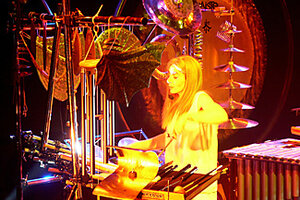Percussionists drum up interest among orchestra fans
A few composers are seeing new possibilities for percussion concertos. At least four such pieces are scheduled in the US over the next month.

Evelyn Glennie, a percussionist, is set to perform with the Pittsburgh Symphony on Feb. 21. Glennie is in good company: there are three other percussion concertos scheduled in the US this winter.
courtesy of James Wilson/eg images
Theatricality is a basic aim of John Corigliano's music. He once wrote a flute concerto inspired by the Pied Piper legend in which the flutist leads a chorus of children off the stage, and a violin concerto based on the film "The Red Violin." But a request a few years ago for a percussion concerto left him stumped. "All I could see were problems," says the Pulitzer Prize winner.
Corigliano says that while he loves to feature the percussion section in his symphonies, he feels that percussion concertos sound "like orchestral pieces with an extra-large percussion section." The soloist is incapable of playing a real melody and his or her identity is lost amid the myriad bangs, crashes, and splashes of the percussion arsenal.
Nevertheless, a consortium of six orchestras had commissioned the composer to write a piece for Evelyn Glennie, the formidable Scottish percussionist. After considering his options, Corigliano decided to focus on melodic instruments such as the vibraphone and chimes, and an orchestra pared down to strings alone.
Glennie will première the concerto, called "TriplePlay," with the Pittsburgh Symphony on Feb. 21. It is one of four – count 'em, four – major percussion concertos being performed in the United States over the next month. The others are by Jennifer Higdon, Steven Mackey, and Kevin Puts, all highly respected composers who have come to the medium quite recently.
These pieces are the latest sign that the percussion concerto, inherently a modern invention, has moved beyond its novelty phase. Orchestra administrators see percussion works as a draw for new audiences, with their athletic spectacle and ability to exploit non-Western sounds. Composers and soloists are increasingly exploring percussion's subtler qualities.
Glennie finds that composers are taking a "less is more" approach to the medium, using fewer instruments in more nuanced ways.
"Percussion is the most adaptable family of instruments," she says. "The biggest challenge is to project percussion in a lyrical way." She adds that one of her favorite pieces is the 2003 Mallet Concerto by Ned Rorem, a composer best known for art songs.
"He made it clear that he was simply going to write a piece of music and it was my job to make it work on percussion. There are no pyrotechnics, just sheer music and therefore we have a timeless piece."
Like Corigliano and Rorem, Mackey resisted traditional drum fireworks. The Princeton, N.J., composer wrote "'Time Release," which focuses on the dark, throbbing sounds of the marimba, at a time when his mother was ill. She died shortly after the piece was finished.
" 'Time Release' is a very serious piece," he explains. "I felt like there's fragility and a vulnerability to the sound of the marimba that I found to be very touching. It's some of my most solemn and grave music."
The Scottish percussionist Colin Currie premièred the piece in 2005 and performed it with the Baltimore Symphony at New York's Carnegie Hall last weekend.
Sometimes a percussion piece can be soft and subtle while delivering on the requisite spectacle. Jennifer Higdon's "Percussion Concerto," also written for Currie in 2005, requires the soloist to dart about the stage playing 17 different instruments, including bongos, Chinese temple bells, and glockenspiel.
"I wanted quite a bit of this concerto to have exquisitely quiet moments because people never think of percussion that way," Higdon says.
One of her more unusual solutions was to have Currie apply a cello bow to the vibraphone with one hand while playing it with a mallet in the other. "It definitely is a workout," says Higdon. "I think the quiet part actually made it harder sometimes."
Christopher Lamb, the principal percussionist of the New York Philharmonic, sees a predictable pattern. Composers may start with modest goals for a concerto, but they'll meet at his studio where he keeps a vast arsenal of drums, cymbals, shakers, and other arcane instruments. The temptation to experiment becomes too great, "and there are all kinds of racks, and drums, and marimbas, and it turns into a van full of equipment," he says.
Nevertheless, Lamb believes that some of the best pieces aren't preoccupied with volume. In 1999, he premièred the "Concerto for Water Percussion and Orchestra" by the Chinese-American composer Tan Dun. The piece, which explores the ritualistic sounds that can be made using water, has long sections of tranquility. "Percussion should be explored more for its colors as a virtuosic instrument," he says. "It's more than a bash festival."
